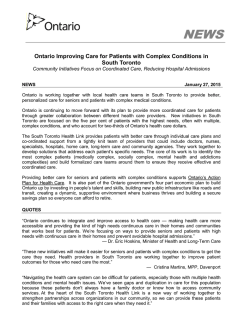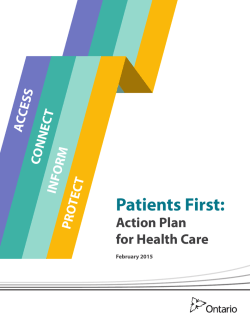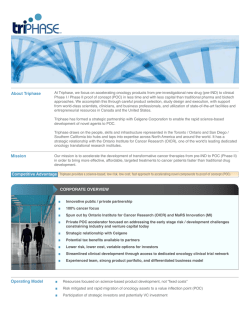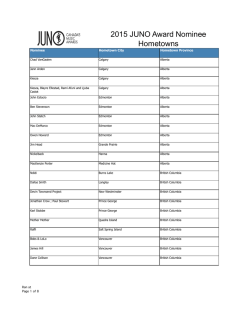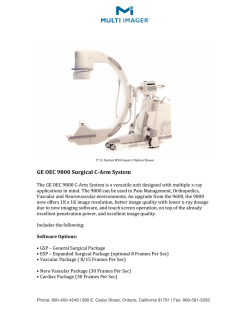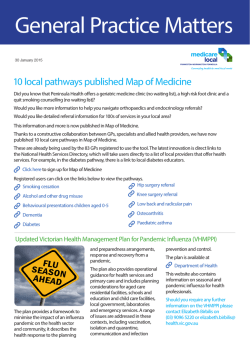
Download a summary of the Ontario Cancer Plan 2011-2015
ONTAR I O C A N C E R P L A N 2011-2015 I want to live... I’m still young, many people in my family have lived to be 100. I want to be around to watch my grandchildren grow up. Screening saved my life, I tell everybody to talk to their doctor about screening. — Eugnia Prountzopoulos, colorectal cancer survivor The 2011-2015 Ontario Cancer Plan Working together to create the best cancer system in the world. Cancer Care Ontario is helping Ontario build the best cancer system in the world. As the government’s cancer advisor and the agency responsible for continuously improving cancer services, CCO focuses on reducing the number of Ontarians diagnosed with cancer and on ensuring high quality care at every step of the patient journey. Cancer is largely a disease of aging. As Ontario’s population ages and grows, the number of people diagnosed with cancer will increase. As well, more patients are living longer with cancer. In order to advance our vision of providing Ontarians with the best cancer system in the world, Ontario’s cancer system needs to respond and adapt. The 2011-2015 Ontario Cancer Plan positions the cancer system to meet the challenge of cancer over the next four years. It continues the transformation of cancer services across Ontario that began with the first Ontario Cancer Plan in 2005 and continued with the 2008 Cancer Plan. It is driven by a commitment to quality in prevention, screening, diagnosis, treatment, follow-up and palliative care as the most effective way to manage cancer. It will pay off in delivering value for money, managing long-term cost growth, improving outcomes and increasing patient satisfaction. The 2011-2015 Cancer Plan focuses on cancer control from the perspective of the patient and is driven by the need to ensure quality across the system. Through this plan, we will: > strengthen our patient-centred approach to cancer control; > continue to improve the quality of the system; and > provide individuals with the knowledge they need to make informed decisions affecting their care. Since 2005, we have learned that we can make the system better. We understand what works and why. With the 2011-2015 Ontario Cancer Plan, we will apply this knowledge throughout the system to continue the transformation of preventive, treatment and palliative services across the province. This plan will bring us a major step closer to realizing our vision of creating the best cancer system in the world. About this document This document provides an overview of the 2011-2015 Ontario Cancer Plan, focusing on our six strategic objectives and what we want to achieve by 2015. A copy of the comprehensive plan is available online http://ocp.cancercare.on.ca. Strategic Priorities 2011-2015 Strategic Priority 1 Develop and implement a focused approach to cancer risk reduction Prevention strategies work in helping Ontarians reduce their risk of developing cancer. By 2015 > Performance measures for cancer prevention initiatives will be in place and publicly reported. > Primary care providers will be given the tools that they need to work with individuals to modify their risks and link them to local resources and screening, where applicable. > Every person in Ontario will be able to calculate their cancer risk profile, based on personal characteristics and grounded in Ontario’s data. This profile will be delivered online and linked to local resources that individuals can use to moderate their risk. > Regional cancer centres will be models in implementing cancer risk reduction initiatives. > A new tobacco control strategy will be implemented. Strategic Priority 2 Implement integrated cancer screening Cancer screening programs can detect cancer in its earliest stages, when it can be most effectively treated for more positive outcomes. By 2015 > Ontario will have one Integrated Cancer Screening strategy for breast, cervical, and colorectal cancer, supported by a single IM/IT System. > Eligible Ontarians will receive invitations and reminders for the appropriate cancer screens at correct time intervals. > Primary care providers will receive reports, tools and supports to enhance their screening performance. Mentoring and support will be provided to doctors as needed. > Local and regional initiatives will be in place to encourage under-screened and/or neverscreened Ontarians to participate in cancer screening. > S upport services will be in place to ensure individuals with abnormal results receive appropriate follow-up care. > Evidence-based guidelines will be established for breast, cervical and colorectal cancer screening. > All breast cancer screening in Ontario will be consolidated into one service for all eligible women. > Each of the 13 Regional Cancer Programs will be accountable for screening programs in their region. > Screening targets at the regional and provincial level will be reviewed regularly to assist in performance management, monitoring and reporting to health system planners. Strategic Priority 3 Continue to improve patient outcomes through accessible, safe, high quality care This plan continues Cancer Care Ontario’s focus on quality, access, the appropriateness and coordination of care, and on improving the patient experience. By 2015 > Disease Pathway Management programs will be developed and implemented for all major cancer types. This will result in improvements in quality of care and the overall patient experience. > Cancer service plans will be in place for all high-volume activities including but not limited to radiation treatment, surgery and palliative care. > Physicians involved in cancer care and control will have access to their own performance data. > Evidence-based guidance will be more readily available and in a more usable format at the point of care. > Ninety percent of chemotherapy treatment visits will be supported by computerized physician order entry, which will reduce errors and increase patient safety. > Specialized oncology nurses will be in place across the cancer system, ensuring safe, highquality patient-centered care as close to home as possible. > S pecialized cancer services will have provincial service plans designed to ensure timely and appropriate access to specialized cancer treatments, such as stem cell transplants. Strategic Priority 4 Continue to assess and improve the patient experience To realize our vision of creating the best cancer system in the world, patients must have more control over their own care to improve satisfaction and outcomes. By 2015 Every cancer patient in Ontario will: > Have access to tools to help navigate the cancer system and manage their own journey. > Transition more smoothly along the care path and experience improved continuity of care among cancer care service providers. > Have the opportunity to give feedback on their experience throughout their cancer journey. > Have the opportunity to report their symptoms electronically to support communication and the provision of care. > Receive care in a timely manner for physical and emotional symptom scores flagged through symptom screening. > Have their performance status, the clinical measure of the patient’s ability to perform normal daily functions, collected to help in the planning of their care. > Have their interests represented at a Patient Advisory Council, a forum to advise on initiatives to improve the patient experience. > Have access to psychosocial resources, standardized across the province and based on international best practices. Strategic Priority 5 Develop and implement innovative models of care delivery New models for the delivery of care are needed to optimize the roles of healthcare professionals and improve care and provider satisfaction. These will be developed using a patient-centred approach that establishes a working partnership with patients, their families, and providers of cancer care. By 2015 > N ew, evidence-based, patient-centred models of safe and effective care will ensure that each person receives the right care by the most appropriate provider in ways that optimize the use of our health human resources. > P atient-centred models of care will be implemented to actively engage patients to promote patient self management to improve patient outcomes. > N ew models of funding and remuneration that support the delivery of multidisciplinary and patient-centred care will be in place to optimize the roles of healthcare professionals and improve care and provider satisfaction. > e-Tools and other information technology solutions will be available to patients to allow them to increase their participation in care and thereby improve system efficiency. Strategic Priority 6 Expand our efforts in personalized medicine Personalized medicine focuses on the science of using a patient’s genetic information to predict cancer and its prognosis, and to diagnose, monitor and select cancer treatments most likely to be of benefit to that individual. It offers enormous potential benefits in improving the performance of Ontario’s cancer system. By 2015 > A responsive system will be in place that is supported by research conducted in partnership with the Ontario Institute for Cancer Research and other CCO partners and that rapidly evaluates and integrates new knowledge into the Ontario cancer system. > T he evaluation and listing process for new drugs and tests will facilitate best-practice care decisions based on patient-specific genetic information and cost-effectiveness evidence. > Patients will have access to high-quality services and the information they need to make knowledgeable and informed decisions regarding personalized medicine. > Patients will have the knowledge they need to guide patient decision-making. Enabling Success Since 2005, we have developed partnerships, competencies, and delivery structures to enable continuous improvements to Ontario’s cancer system. The success of this Cancer Plan also relies on these enablers, including: > Information Management and Information Technology for both clinical and administrative practice have been integral to our success in improving cancer system quality, accountability and performance and the patient experience. > Regional Cancer Programs led by Regional Vice Presidents in each Local Health Integration Network (LHIN). These programs are the primary mechanism for implementation of the Ontario Cancer Plan at the regional level. > Capital projects, including the building of new cancer centres, the redevelopment and expansion of existing centres, and the timely replacement of aging major radiation treatment equipment, to ensure timely access to high-quality cancer care as close to home as possible. > The Program in Evidence-Based Care (PEBC), a CCO program with a mandate to develop, disseminate, and evaluate evidence-based standards, guidelines and other advice documents for use in clinical, planning and policy decisions about cancer control. > Research to accelerate the development and application of knowledge relevant to reducing the burden of cancer. > O ur partners including the Government of Ontario through our funder, the Ontario Ministry of Health and LongTerm Care, the Ontario Ministry of Health Promotion, the Ontario Agency for Health Protection and Promotion and public health units with whom we work on prevention and screening initiatives; Regional Cancer Programs; hospitals; healthcare service providers including oncologists and other specialists, family physicians and nurses; cancer control researchers and research bodies such as the Ontario Institute for Cancer Research and the Canadian Centre for Applied Research in Cancer Control; the Canadian Cancer Society and other charitable agencies focused on reducing the burden of cancer; patients’ groups and patients. A copy of the comprehensive plan is available online at http://ocp.cancercare.on.ca
© Copyright 2025
